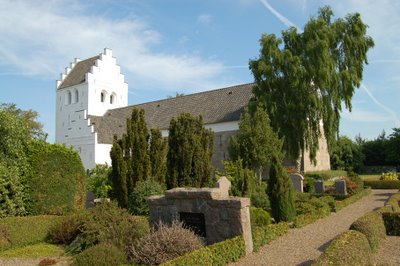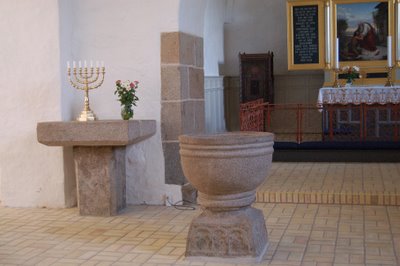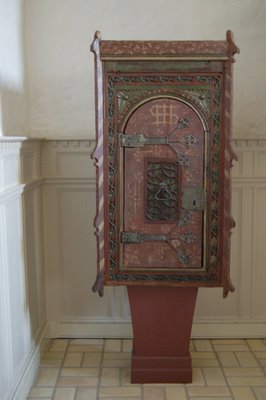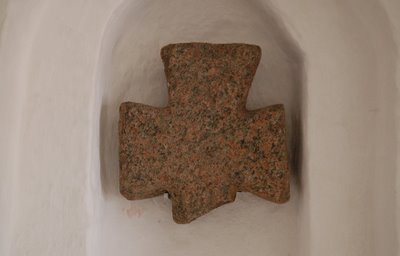
Kollerup Church, Thy
A few km northeast of the town Fjerritslev


The old Romanesque Communion table, which had a reliquary, has got a pretty place left of the new altarpiece.

A piece from a monstrance cabinet.

A piece of Romanesque gravestone

The medieval door of broad oak planks
The church is situated only 10 km from Svinkløv and Grønne Strand by the North Sea. It has a Romanesque nave, a late Gothic longhouse choir, a western tower and a southern porch and a chapel at the north side of the nave from 1591. The Romanesque nave of which only the flankemurene (flank-walls) are preserved is built in granite aslars. Both doors are preserved , but somewhat changed. From the windows only a round-arched window with a monolit coverstone in the north wall of the nave is preserved. Four other monolit coverstones are bricked-up in the north wall of the chapel, put together to two small niches, while two stones are placed above its north door. In a couple of re-used ashlars in the east wall are some carved lines which form various not very visible figures. In the wall also a chessboard ashlar. From the demolished choir-arch origin probably some vaguely profiled ashlars in the north wall.
In the late Gothic period ab. 1500 the Romanesque choir was replaced by a longhouse choir in re-used ashlar-material and yellow monk bricks. At the same time the walls of the nave were heightened and in the whole building was built five octagonal cross-vaults and a pointed choir arch. The gable triangle in the east was re-walled in 1653 and 1681. The tower is also late Gothic in the same materials, re-used ashlars and yellow monk bricks. Its cross-vaulted bottom room, which is now a tool shed, has a pointed tower arch. Also the two storey-porch to the south is late Gothic. The octagonal vaulted chapel in the north side of the nave is connected to this in a large flat round arch. Its northern part was after 1952 divided into a boiler room and a priest room, when the whole building was restored.
The Romanesque communion table rests upon a square pillar and in the top is a reliquary. The altar piece from 1883 is a simple joinery with a painting from 1898. A Romanesque granite font with archade decorated pyramid foot. The baptismal bowl is pewter from 1689 with a Baroque engraving. The pulpit from 1599 is a rural copy of an Aalborg-type with naive reliefs and a contemporary sounding board. "Lord of the Manor"- pews from 1590 with the coat of arms and names of: Henrik Gyldenstierne and Mette Rud. From a very pretty monstrance cabinet with fine ornaments and rich wrought-iron mounting the cabinet is preserved. Church bells 1) ab. 1450-75 by PLP 2) 1620 by Rudolph Borchardt. A door wing in broad oak-planks is placed in the wall of the north door.
Gravestones: 1) Romanesque with a flat-relief of a Sct. George cross 2) Romanesque with an indefinable figure 3) Fragment of a Romansesque grave cross.
Names in the Middle ages and the 1600s:
Kollerup (1455 Koldrvp); Brøndum (1401 Brwnnæm); Borup (1450 Borup); Andrup (1462 Amdrvp); Vester Hingelbjerg ( 1455 Hingilberg); Aldrup (* 1462 Altrop, 1479 Aldrop); Nr. and Sdr. Dromshave (*1508 Droms waadt, 1626 Drumbshafve, 1688 Nøre-, Synder Droms Hage); Graven (1664 Graffuen); Årup (1542 Aarup Gaard); Bjergegård (1678 Bieregaard) ; Pedersbæk (1552 Persbeck).
In 1455 and 14734 the væbner Esge Bonde of Borup is mentioned. In 1462 he is called a peasant, although he belonged to the noble family Bonde of Thy, knighted in 1430.
In 1455 Jap Skytte of Hingilberg is mentioned, in 1462 the væbner Bord Jensen in Amdrup , and in 1470 and 1504 Ylfar Eskesen of Brøndum. In 1504 he sold to the prior of Vrejlev kloster a part of Størup and Clettrup (in Skallerup parish, Vennebjerg herred, Hjørring amt), which he had inherited after his wife Dorte Pallesdatter and his children.
An agreement was made in 19/9 1474 ab. a Skt. Jørgens Kapel in Kollerup between the Børglum-bishop and Mourids Nielsen Gyldenstierne of Ågård that a priest had to be engaged in order to be in receipt of people's charities and gifts.
During the 1600s the parish suffered much from sand drift.
Listed prehistorics: already Pontoppidan's Atlas mentions that there were heathen gravehills, dolmens and sacrificial places in the parish. The parish is very rich in prehistorics of which a large number are listed: Northwest of the church is a hexagonal dolmen with a cover stone; at Brøndum a long dolmen and a passage grave, of which only a few cover stones are visible; in the dunes at Andrupgård is a disturbed passage grave, where were found a flint axe, arrow heads, amber pearls and clay pot pieces; furthermore 52 hills of which several are large.
At several places in Kollerup plantation are noted Stone Age settlements, mainly from dolktid (a period of 700 years from ab. 2400 bc ). In a bog were found 11 sickles from early Bronze Age. At Hingelbjerge were 10 small hills with jordfæstegrave ( burials where the body was placed unburnt in a wooden coffin or just in a hole in the ground, i.e. swept in a leather cape) from the Viking Period, several with weapons.
Source: Trap Danmark, Thisted amt, 1961
photo 13 June 2006: grethe bachmann
No comments:
Post a Comment